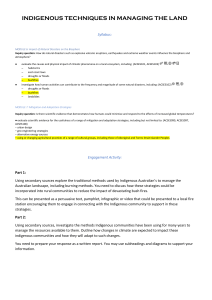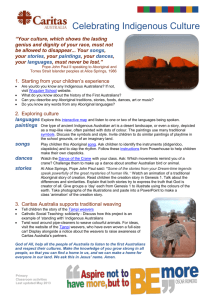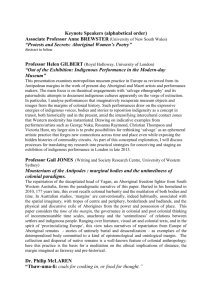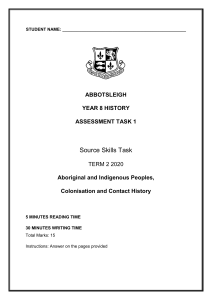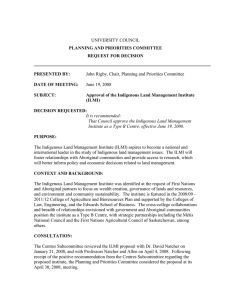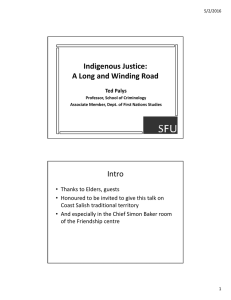Identity and Identification – Traditional Australian Indigenous processes
advertisement
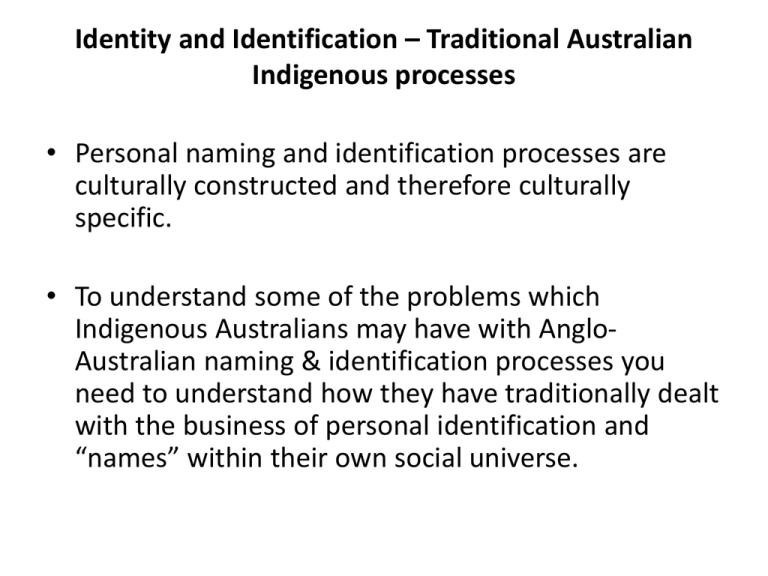
Identity and Identification – Traditional Australian Indigenous processes • Personal naming and identification processes are culturally constructed and therefore culturally specific. • To understand some of the problems which Indigenous Australians may have with AngloAustralian naming & identification processes you need to understand how they have traditionally dealt with the business of personal identification and “names” within their own social universe. Rod Hagen PhD Candidate Law Faculty Monash University Achieving Universal Birth Registration Symposium 2 December 2014 Melbourne • Western civil registration and ID systems generally have the clear & stable identification of the individual to the state as their primary purpose. • In traditional Aboriginal communities this is rarely at issue and “names” can be used to convey very different information such as status, kinship relationships, the relationship of the speaker to the person named, and current personal circumstances of the individual concerned. • Doussett identifies ten primary categories of “names” used by the Ngaatjatjarra: • • • • • • Section names (commonly called “skin names”) which although possessed were less frequently used as a form of address than in many Central Australian groups Bush names, derived from the Tjukurrpa and generally heavily restricted or prohibited for public use. Names passed through the “Kalyartu” relationship, in which a grandparent transmits his or her names and personality to their grandchild. Names based on a place or a parent. Used to avoid using a “bush name” based on a place name with the affix “-nguru” or “nguraru” - “of the place” or the name of a parent with “-kurnu” - “child of”. A “birth name” - given at birth but not used until a child is walking / leaving tracks. various non secret-sacred identifiers based on fauna, flora or physical elements and characteristics. • Aboriginal “nicknames” - called “yinni watjarnu” equating to “spoken name”. In this area generally only used for reference, rather than to directly address a person, who may be offended by its use (in contrast with Thomson’s comments about such names amongst the Wik Moŋan) and generally related to a physical characteristic of the person. • descriptive names, especially at times of bereavement (for example, equivalents to “the man who lost his sibling”) European names - used with increasing frequency in public situations, but not displacing other forms of more restricted name. Both first names and surnames are used, though surnames do not necessarily follow the male line if political advantage lies elsewhere. Substitutions and transformations in the event of a death. In this area “kumarrnara” fulfils the same role as “kwementyay”. when a name or its homophone is prohibited as a result of a death. Other homophonically similar words to the name of the deceased person may also be • • phonetically changed to reduce the dissonance produced. • Names used in Anglo-Australian culture are generally quite stable throughout life (or have predictable changes, such as , for some, as a result of marriage or remarriage) & the number of changes in a lifetime is generally limited in number. • Names in traditional Aboriginal communities are highly variable – they change with age, status, the death of similarly named people, even the death of a parent or significant other. • A single Aboriginal individual is likely to be known publicly by a wide variety of names, depending on their relationship to the speaker, the circumstances, etc. • Formal, enduring, names in Anglo Australian society can generally be spoken freely, and form the basis of “civil registration” processes. • Use of formal, enduring, names in traditional Aboriginal communities are usually highly proscribed – forbidden except in specific ritual contexts, only used by specific, highly credentialed, speakers, and even then offered in hushed terms especially if the subject of the name is present. • Accordingly in traditional communities the more traditionally “formal” names are never used for birth registration or government identification. Ephemeral, Anglo-Australian “nicknames” are used instead. • Even when Anglo-Australian names are used, prohibitions can arise if a person of the same or a similar name dies. • While in Western societies the clear identification of people serves the needs of the state at least as much as the individual, there is some “balance” in the process. People perceive real rights flowing from the identification & registration process (pensions, inheritance, voting, etc). • For most of the time since Anglo occupation of Australia, though, official identification processes by Gov & Missions for Indigenous Australians has focused on refining social control, assessing “assimilability”, measuring the extent to which people need “management”, or selecting for the application of discriminatory policy. Dissonances in the literature? A body of human rights law that , quite rightly, points to the problems that can occur today when people have no access to an official personal identity. A body of anthropological and socio-historical literature that, quite rightly points to the effects, often deleterious, of the imposition of non-Indigenous (primarily Western) “naming” and identification processes on traditional societies. A body of historical & political science literature that points to the misuse systems of personal identification, especially with respect to Indigenous & other minority groups. • Human Rights activists and agencies such as the UN have tended, with some justification, to see processes like birth registration and certification as unequivocally “good”. • Different uses that state identification processes have been put to, though, especially where Indigenous minority groups are concerned, doesn’t always provide a pretty picture. Identification processes DO go wrong: • The Canadian “Project Surname” of the 1960s & 70s intended to replace the equally disastrous 1930s “dog tag” system for Inuit people. • The abuse of racial information contained in birth registration records in Nazi Europe. • Forms of identification which can lead to stigmatisation, or worse, for minority groups generally, whether they be Indigenous peoples, Asylum seekers, religious minorities. “The relationship between birth registration and access to other children’s rights and services was found to be complex and context specific. It is important to recognise that birth registration is only one component of a governance and legal system that could protect and promote children’s rights. Birth registration should not be implemented in isolation. Any birth registration initiatives should be integrated with other measures to fulfil children’s rights, such as governance, protection, education and health care and should be part of a comprehensive civil registration and vital statistics (CRVS) system.” (Plan International 2014) Apland, K., Hamilton, C., Blitz, K., Lagay, M., Lakshman, R, Yarrow, E. Birth Registration and Children's Rights: A Complex Story Plan International, 2014 p.4 - http://plan-international.org/files/global/publications/campaigns/birthregistration-research-full-report.pdf Its not just about getting numbers of registrations up! • Are more nuanced approaches required to prevent civil registration causing harm as well as good to Indigenous groups in Australia and elsewhere? • Is it possible to develop systems that are better attuned to traditional processes than the systems we see in place in Australia and much of the rest of the world? • How do we better balance contemporary societal demands for personal identification with Indigenous processes and historical concerns?
